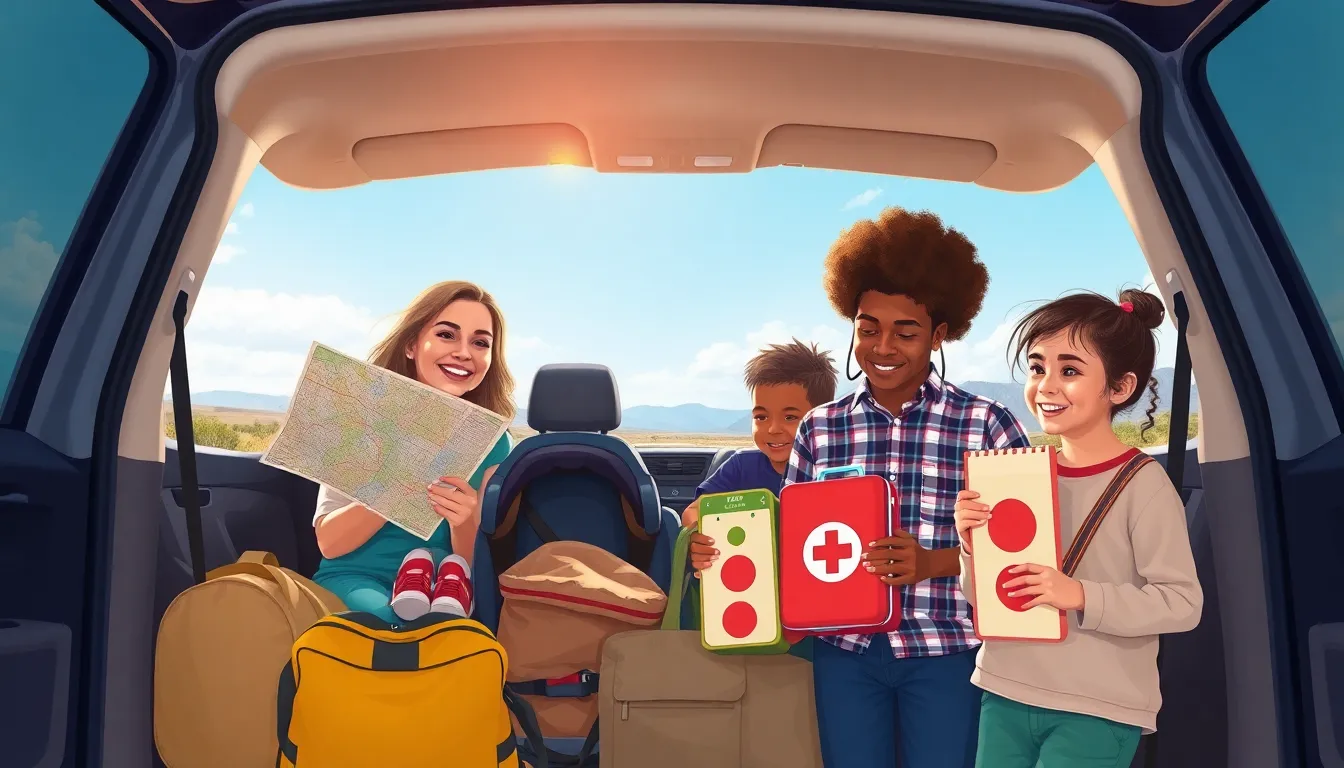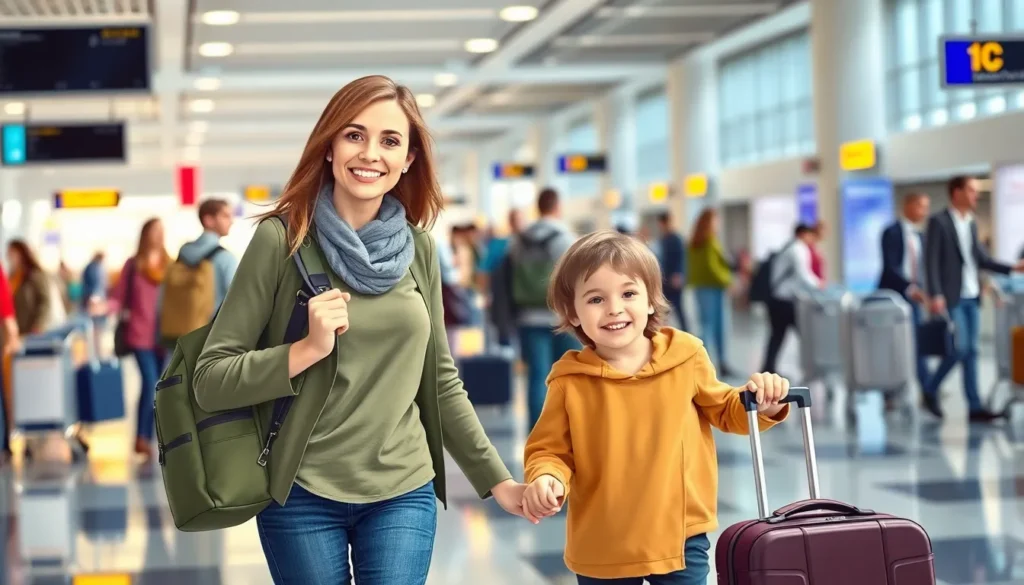Table of Contents
ToggleTraveling with family can be a thrilling adventure filled with laughter and unforgettable memories. But let’s face it—keeping everyone safe while navigating airports, hotels, and road trips can feel like herding cats. From toddlers who think they can outrun a security line to teenagers glued to their screens, family travel safety is no laughing matter.
Understanding Family Travel Safety
Family travel safety encompasses various practices that protect everyone during trips. Prioritizing safety ensures parents can focus on creating enjoyable experiences without unnecessary risks.
Importance of Travel Safety for Families
Travel safety plays a vital role in family trips. Engaging in careful planning mitigates potential hazards. Parents must remain vigilant to prevent accidents, especially in crowded spaces. Creating safety protocols, such as holding hands in busy areas, enhances children’s security. Awareness can also foster a sense of responsibility among older siblings. By maintaining an open dialogue about safety, families can navigate potential dangers more effectively. Preparing for emergencies, such as knowing local medical facilities, contributes to a smoother travel experience.
Common Safety Concerns for Family Travel
Common safety concerns arise when traveling with children. Medical issues, such as allergies, often require careful management. Additionally, the risk of getting lost in unfamiliar locations remains significant. Noise levels can lead to misunderstandings if children cannot hear instructions, so staying close together remains essential. Traffic safety poses another challenge, especially when crossing streets or navigating parking lots. Properly securing car seats and seat belts reduces the risk of injury during car travel. Understanding these safety concerns enables families to plan effectively and maintain a secure environment throughout their journey.
Pre-Travel Safety Preparations

Preparing for family travel requires thorough planning to ensure safety throughout the journey. Focus on important details that contribute to a secure experience.
Researching Your Destination
Understanding the destination’s safety regulations helps families navigate potential risks. Review local emergency services and hospital locations for convenience in case of medical needs. Check travel advisories from authoritative sources like the U.S. Department of State for updates on safety conditions. Research local traffic laws, which can differ significantly from common practices. Knowing the culture and customs of the area prepares families for appropriate behavior, minimizing misunderstandings. Look into family-friendly accommodations with positive reviews to enhance safety and comfort.
Packing Safety Essentials
Families should include essential safety items when packing for a trip. Among the crucial items are first aid kits, which should contain band-aids, antiseptic wipes, and allergy medication. Consider packing a map or portable GPS device for navigation in unfamiliar areas. Include emergency contact information and health insurance details for easy access in case of emergencies. Extra snacks and water are vital for managing hunger and dehydration, especially during travel delays. Finally, ensure that car seats and seat belts conform to safety regulations at the destination.
Transportation Safety
Transportation safety is crucial for family trips. Different modes of travel can impact the journey’s overall safety and comfort.
Choosing the Right Mode of Travel
Selecting the right travel mode relies on family preferences and destination factors. Families can opt for driving, flying, or taking public transport. Driving allows more control over schedules and stops, ensuring frequent breaks suit children’s needs. Flights can save time but entail security checks and waiting periods. Public transportation offers affordability, though families should remain cautious in crowded areas. Analyzing the safety records of each option adds another layer of assurance, especially with respect to local transportation standards. Consider travel duration and children’s patience levels when weighing choices to enhance overall travel experiences.
Vehicle Safety Tips for Families
Ensuring vehicle safety involves several key practices. Always use appropriate child safety seats based on age and weight. Seat belts should also fit all family members correctly. Regularly check vehicle maintenance for good performance. Avoid distractions while driving to keep attention focused on the road. Additionally, familiarize yourself with traffic laws specific to your travel area to prevent violations. Packing emergency supplies, like first aid kits and extra water, prepares families for unplanned situations. Limiting vehicle speed enhances safety, especially in unfamiliar places. Adopting these practices creates a secure environment while traveling.
Accommodation Safety
Prioritizing accommodation safety ensures a secure environment for families while traveling. Different aspects contribute to this, including choosing the right type of lodging.
Selecting Family-Friendly Hotels
Choosing family-friendly hotels enhances the travel experience. Look for properties that provide amenities tailored to families, like kid-friendly meals and play areas. Prioritize hotels with spacious rooms since larger areas offer more comfort and less stress. Verify that the hotel allows multiple guests per room, accommodating families seamlessly. Additionally, checking reviews from other families can provide insights into safety and comfort levels.
Safety Features to Look For
Identifying safety features is crucial when selecting suitable accommodation. Seek hotels equipped with secure locks and in-room safes for personal belongings. Ensure smoke detectors and carbon monoxide detectors are present, as these protect against emergencies. Assess if the hotel has 24-hour security or surveillance systems in place, increasing peace of mind. Finally, review the distance to emergency exits and the overall layout of the accommodation, ensuring easy accessibility in case of emergencies.
Health and Emergency Preparedness
Health and emergency preparedness are crucial components of family travel safety. Keeping everyone healthy and having a plan in place can make any trip more enjoyable.
Health Precautions for Family Travel
Health precautions start with vaccinations. Ensuring all family members receive necessary vaccines, based on destination requirements, can minimize health risks. Packing prescription medications and necessary medical supplies, like inhalers or allergy medications, proves essential. Keeping a first aid kit stocked with essentials, such as band-aids, antiseptic wipes, and pain relievers also helps manage common travel ailments. Staying aware of local health advisories further assists families in adapting to any potential health threats. Maintaining hydration during travel and seeking nutritious food options help keep energy levels up.
Emergency Contacts and Plans
Emergency contacts and plans form the backbone of safety during family trips. Creating a list of local emergency services, such as hospitals and police stations, increases preparedness. Share contact details for family members, including cell phones and email addresses. Discussing a shared emergency meeting point in case family members become separated ensures everyone knows where to go. Establishing a communication plan also alleviates anxiety in the event of emergencies. Teaching children how to recognize local authority figures, such as police officers or security personnel, enhances their safety awareness. Regularly reviewing these protocols reinforces the importance of staying connected while traveling.
Prioritizing family travel safety transforms trips into enjoyable adventures rather than stressful experiences. By implementing effective safety measures and thorough planning, families can navigate busy environments with confidence. Staying informed about local customs and regulations further enhances safety while fostering a sense of responsibility among children.
Equipping families with essential tools and knowledge allows them to focus on creating cherished memories. Ultimately, a commitment to safety ensures that every family trip is not only memorable but also secure, paving the way for countless joyful experiences together.







